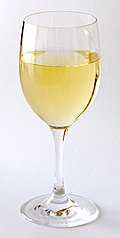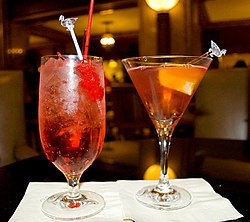

Drinks are a part of survival. Drinks are liquids that can be consumed, with drinking water being the base ingredient for many of them. In addition to basic needs, drinks form part of the culture of human society. In a commercial setting, drinks, other than water, may be termed beverages. [1]
Contents
- Alcoholic drinks
- Beer
- Cider
- Distilled (liquor)
- Hard soda
- Wine
- Non-alcoholic drinks
- List of traditional non-alcoholic drinks
- Plant-based
- Soft drinks
- Caffeine-containing drinks
- Chocolate
- Other psychoactive drinks
- Cannabis-infused drinks
- Polysubstance drinks
- Miscellaneous
- Hot drinks
- By temperature
- Brands and companies
- By country 4
- Historical
- See also
- References




















